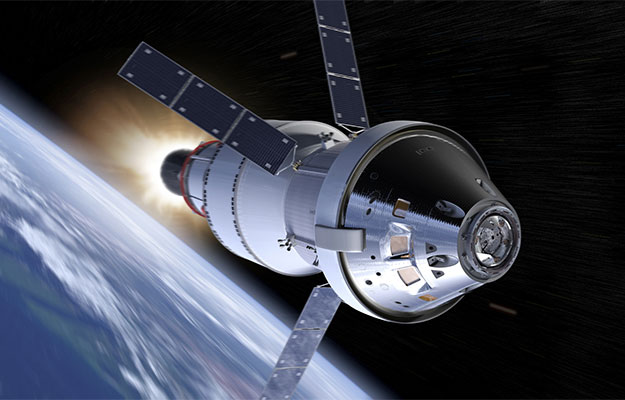NASA Contemplates Adding Astronaut Crew To First SLS, Orion Deep Space Mission
The National Aeronautics and Space Administration (NASA) is working to literally “boldly go where no man has gone before”. NASA is currently assessing the feasibility of adding a crew to the first integrated flight of its Space Launch System (SLS) booster and Orion spacecraft on Exploration Mission-1 (EM-1). The project's ultimate goal is to send human beings into deep space as part of a Mars or Asteroid Redirect Mission.

William Gerstenmaier, associate administrator for NASA’s Human Exploration and Operations Mission Directorate in Washington, is in charge of the study. He will assess the risks and benefits of such a mission as well as the additional resources and work needed to add a crew to Orion. Gerstenmaier will determine whether it would be possible to add two crew members to the Orion spacecraft and launch in the middle of 2019.
The first mission of the SLS and Orion was originally set to be a distant lunar retrograde orbit. The mission would require propulsion moves, a flyby of the moon and return trajectory burns in order to test maneuvers and the environment that would be needed for deep space. Orion would soar around 62 miles (100 km) above the surface of the moon and use the moon’s gravitation force to propel itself into a deep retrograde route. It would enter an orbit about 40,000 miles (70,000 km) from the moon and stay in that position for six days. Orion would then once again use the moon’s gravitational force to accelerate back to Earth. It would enter the atmosphere at 25,000 mph (11 kilometers per second) and produce temperatures up to 5,000 degrees Fahrenheit (2,760 degrees Celsius). The original mission would last for roughly two weeks.
If a flight crew is added, however, the first mission would likely be replaced with the plans for Exploration Mission-2. This mission is an eight-day multi-translunar injection with a free return trajectory. This second mission would skip the retrograde and the use of the moon’s gravitational force to return to Earth.
NASA just recently completed the SLS structural test stand and engineers are developing the necessary equipment to test the rocket’s largest fuel tank. The stand will hopefully ensure that the SLS will be able to withstand the forces of launching.
Whatever the outcome of the study, NASA is still set to launch in 2019. Hardware for the first flight has already started to arrive at the Kennedy Space Center in Florida. It will launch from the Pad 39B, just a short walk from historic Pad 39A where SpaceX recently launched. Pad B was the starting line for the astronauts of Apollo 10 and on the Apollo-Soyuz Test Project mission before it became the centerpiece of shuttle lift-offs. Pad B was last used for the Ares I-X flight test in 2009 and has since been refurbished.

William Gerstenmaier, associate administrator for NASA’s Human Exploration and Operations Mission Directorate in Washington, is in charge of the study. He will assess the risks and benefits of such a mission as well as the additional resources and work needed to add a crew to Orion. Gerstenmaier will determine whether it would be possible to add two crew members to the Orion spacecraft and launch in the middle of 2019.
The first mission of the SLS and Orion was originally set to be a distant lunar retrograde orbit. The mission would require propulsion moves, a flyby of the moon and return trajectory burns in order to test maneuvers and the environment that would be needed for deep space. Orion would soar around 62 miles (100 km) above the surface of the moon and use the moon’s gravitation force to propel itself into a deep retrograde route. It would enter an orbit about 40,000 miles (70,000 km) from the moon and stay in that position for six days. Orion would then once again use the moon’s gravitational force to accelerate back to Earth. It would enter the atmosphere at 25,000 mph (11 kilometers per second) and produce temperatures up to 5,000 degrees Fahrenheit (2,760 degrees Celsius). The original mission would last for roughly two weeks.
If a flight crew is added, however, the first mission would likely be replaced with the plans for Exploration Mission-2. This mission is an eight-day multi-translunar injection with a free return trajectory. This second mission would skip the retrograde and the use of the moon’s gravitational force to return to Earth.
NASA just recently completed the SLS structural test stand and engineers are developing the necessary equipment to test the rocket’s largest fuel tank. The stand will hopefully ensure that the SLS will be able to withstand the forces of launching.
Whatever the outcome of the study, NASA is still set to launch in 2019. Hardware for the first flight has already started to arrive at the Kennedy Space Center in Florida. It will launch from the Pad 39B, just a short walk from historic Pad 39A where SpaceX recently launched. Pad B was the starting line for the astronauts of Apollo 10 and on the Apollo-Soyuz Test Project mission before it became the centerpiece of shuttle lift-offs. Pad B was last used for the Ares I-X flight test in 2009 and has since been refurbished.

